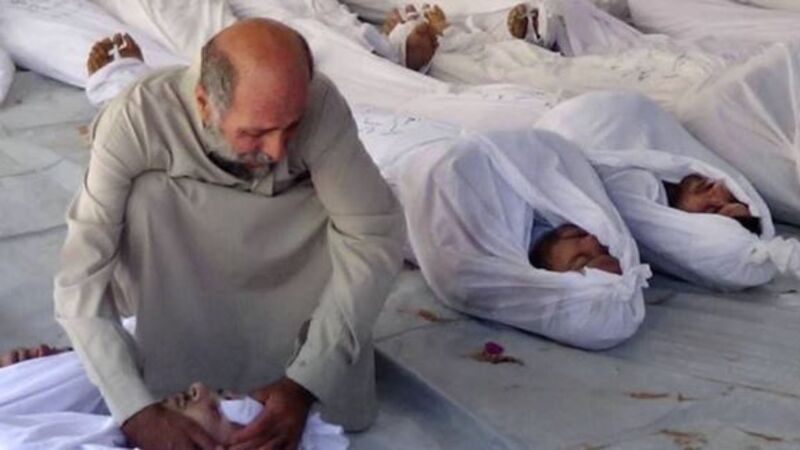Your questions on chemical warfare answered?

Now, a team of UN weapons inspectors are at the site to determine what happened. If the inspectors conclude that the Syrian regime launched a chemical attack on its own people, then outside intervention in the conflict will become more likely.
Military analyst and former army officer Tom Clonan, who has served in the Middle East and the former Yugoslavia, explains the planning behind chemical attacks, how they are carried out, and what symptoms the victims would have gone through.
Q: What exactly is a chemical attack?
A: A chemical attack is when you get something like an artillery shell or mortar round, a projectile, and instead of filling it with high explosives and shrapnel, you fill it with liquid chemical agents. Then the artillery round, or artillery bomb if you’d like, with the agent inside, is fired at a target. It explodes and disperses the chemical agent either in liquid or aerosol form.
Q: What kind of planning goes into an attack such as this?
A: Typically an attack would start with something called an adjusting round or smoke round. A smoke round would be fired from an artillery piece. Those behind the attack would watch where the smoke round lands and watch how the smoke behaves — is it dispersed quickly by the wind in the area? Is it blowing back toward the people who fired it or is it blowing away toward the target area? After that initial phase, the chemical agent itself would be fired multiple times in order to build up a sufficient amount of the gas or liquid or aerosol for it to kill.
Q: Are there different kinds of chemical agents?
A: There are a few different types: Nerve agents, blood agents, choking agents, and blister agents. All are lethal. The type of attack that is believed to have taken place in Damascus is a nerve agent, a neurotoxin.
Q: How are these chemical agents deployed?
A: You can, technically, fire chemical weapons in missile warheads. The Assad regime are believed to have a small number of missiles that are capable of delivering a chemical warhead with sufficient range to get it out of Syria’s borders into a country such as Israel, Jordan, or Lebanon. However, it’s not clear if the regime is capable of mounting such an attack because of the war and their degraded infrastructure. We do know, however, that they have thousands and thousands of what we call chemical shells — liquid filled artillery rounds that can be fired by conventional artillery weapons. If the regime were to use chemical weapons, it is most likely they would use this kind of conventional delivery system. They would be fired local to the target with a range of about 20km.
Q: What happens when people are exposed to chemical agents?
A: If a droplet of a chemical agent gets on your skin, death can be as quick as three minutes or it can be as slow as eight to 10 hours. It affects an enzyme called cholinesterase. When that enzyme is compromised, your body can’t send signals to your lungs and you can’t breathe. You go into seizures and convulsions and then you suffocate. It’s an extremely painful death. If it’s a weaponised, high-grade chemical weapon, it will be persistent — the first responders will also fall victim to it anything up to 18 hours after the attack. This is consistent with reports from Médecins Sans Frontières that some of the doctors and nurses that treated the victims became symptomatic themselves.
Q: What are the UN inspectors looking to find in Damascus?
A: Eyewitness accounts are saying that there were seven detonations in each of the three targeted areas. Those accounts seem to fit with the idea that chemical weapons were fired by conventional means, which would point to the Assad regime. There’s also the possibility that rebels may have gotten their hands on stockpiles of chemical weapons and used them with some sort of improvised explosive device.
That’s what the UN weapons inspectors will try to establish in the next few days. They’ll go in and visit the areas the detonations took place, they’ll look for shell fragments, they’ll do what’s known as a crater analysis to ascertain the type of blast and the amount of explosive energy it had.
They will also try to take samples, any residue of the chemical agents, to see how toxic the agent was.
If the agent was weaponised, it will be very, very toxic and should leave a clear signature, or residue, at the point of impact.
If they have medical expertise, they’ll probably try to take tissue and blood samples from victims. If they have time and facilities, they would likely exhume some of the bodies to carry out post-postmortems.
Q: Who do you think is behind the attack?
A: My instinct is that a chemical agent was used, but the big question is by whom and for what purpose. The Assad regime will allege that the rebels did it to provoke the kind of military response that is now being suggested by Britain’s prime minister David Cameron. The Americans, the French and the British will allege that the regime is doing this because it’s a campaign of terror, a no-holes-barred struggle for survival for the regime and that they’re quite prepared to use these kinds of indiscriminate and brutal weapons against their own citizens.
If the UN inspectors find evidence of conventional artillery strikes, one would assume then that it was the Syrian army — the rebels wouldn’t be able to assemble those kinds of weapons and fire them in such a co-ordinated way, they don’t have that kind of infrastructure you see, they’re more of a guerrilla organisation.
Q: How long will the site in Damascus remain contaminated?
A: The concept behind chemical weapons is to kill people but to leave buildings and equipment and infrastructure intact. So it would be contaminated for maybe 72 hours. After that, you could begin to move in and clear the dead and hold that ground.
Q: What implications could this attack have on world politics?
A: There has been pressure on the Obama administration to do something about this, but it’s such a complex situation that it’s difficult for anyone to intervene. If the UN inspectors conclude that the Assad regime was involved, it gives Britain and the US the opportunity to do something. So they would probably announce that they’re going to go in and destroy President Assad’s chemical weapons stocks.
If they can show chemical weapons have been used, they’ll go in and use missile and air strikes to destroy the chemical weapons stocks. They’ll also use that opportunity to destroy air defence infrastructure and radar, command of controls, all of those assets would be destroyed in such an attack in a 48 to 72-hour operation.
In an operation like that, the risk of collateral damage, to use that awful expression, the risk of civilian casualties, will be huge. Syria is a very densely populated country.
There’s no doubt in my mind that if the Americans and the Brits decide to do this, to have a clear, surgical destruction of the chemical weapons, there’s going to be hundreds and hundreds of innocent civilian casualties.
If the weapons inspectors come out with a sniff that this was Assad’s regime, I think the Americans will do something. And I don’t think they will wait for a UN Security Council resolution.















